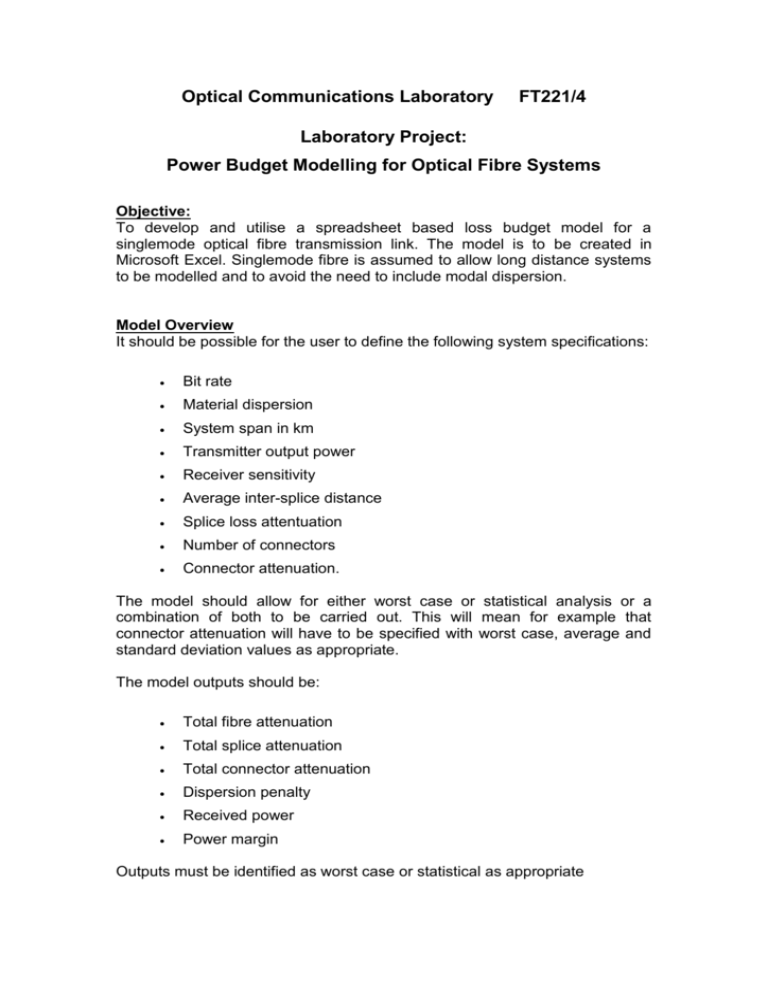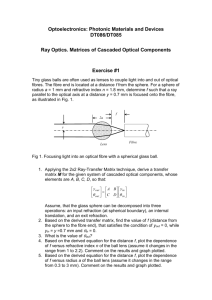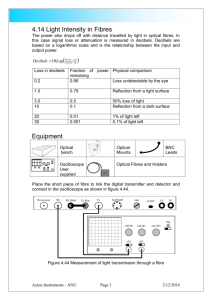Power budgeting for optical transmission systems
advertisement

Optical Communications Laboratory FT221/4 Laboratory Project: Power Budget Modelling for Optical Fibre Systems Objective: To develop and utilise a spreadsheet based loss budget model for a singlemode optical fibre transmission link. The model is to be created in Microsoft Excel. Singlemode fibre is assumed to allow long distance systems to be modelled and to avoid the need to include modal dispersion. Model Overview It should be possible for the user to define the following system specifications: Bit rate Material dispersion System span in km Transmitter output power Receiver sensitivity Average inter-splice distance Splice loss attentuation Number of connectors Connector attenuation. The model should allow for either worst case or statistical analysis or a combination of both to be carried out. This will mean for example that connector attenuation will have to be specified with worst case, average and standard deviation values as appropriate. The model outputs should be: Total fibre attenuation Total splice attenuation Total connector attenuation Dispersion penalty Received power Power margin Outputs must be identified as worst case or statistical as appropriate After completion of the above extensions to the basic model may include: Optical amplifiers Optical splitter and other passive components Other penalties and margins Sample and Background: A simple sample model, based on a worst case analysis is provided in Appendix A. Background material, including example power budget calculations, are contained in Appendix B. Further information is contained in the associated lecture notes. Appendix A Simple Sample Model Table 1. below presents a simple power budget calculation for the link shown in Figure 1, which derives the available power margin as an answer. In the columns A and B is the available or given information, while in columns C and D is the derived or calculated information. A B C D Basic Information Value Derived Information Value System Span in km 70.00 Transmitter Output Power (dBm) 0.00 Number of Connectors 2.00 Connector Loss (dB) 0.20 Total Connector Loss (dB) 0.40 Fibre Attenuation 0.25 Total fibre attenuation (dB) 17.50 Maximum fibre length available (km) 0.90 No. of fibre lengths needed 77.78 Average loss per splice (dB) 0.08 Total splice loss (dB) 6.14 Receiver sensitivity (dBm) -28.00 Available power margin (dB) 3.96 Table 1. Power budget calculation Notice that a single length of fibre does not span the distance between the connectors at the transmitter and receiver. Instead fixed lengths of fibre are used, joined by fusion splices. This is taken into account in the model. Transmitter Receiver Legend Optical Fibre Connector Optical Fibre Splice Optical Fibre Figure 1. Optical transmission system model Using the Simple Sample Model Using the spreadsheet model solve the following problems: 1. What is the maximum system span in km which can be catered for? 2. Assuming that a fibre repair margin of at least 2 dB is required, what is the maximum system span? 3. If the maximum fibre length available is altered to 1.4 km, without altering any other parameters, how does the power margin change? 4. Use the model to determine and plot the sensitivity of the power margin to changes in the following parameters: Fibre attenuation Connector loss Transmitter output power Splice loss System span For example for fibre attenuation increase the attenuation from in 2% steps, noting the value of the power margin each time, then plot the value of the power margin as a function of the percentage increase in fibre attenuation. Appendix B Support notes on power budgeting The performance of optical transmission systems In an optical transmission system the distance between the transmitter and the receiver is spanned by an optical fibre. If the optical fibre was a perfect transmission medium then both the operating distance between the transmitter and receiver and the bit rate could be arbitrarily large. In practice however optical fibre possesses inherent limitations that restrict both the maximum distance and the maximum bit rate. If the optical power available at the input to the receiver is too low then the error probability will become unacceptable. This can be seen in figure 1 which plots the error probability against the received optical power for a typical optical transmission system. In this figure as the received optical power increases, for example due to a reduction in fibre attenuation, the error probability gets smaller, which is an improvement. Figure 1 Variation of error probability with received optical power One of the major specifications laid down when an optical transmission system is under development is the acceptable error probability at the planned bit rate. Based on this specification and on a knowledge of the receiver it is possible to specify a minimum acceptable received optical power, below which the error rate specification will not be met. Given this figure for the minimum received optical power the system designer can then estimate the tolerable reduction or attenuation in optical power caused by the fibre and other components such as optical fibre connectors and fibre fusion splices. This process is called power budgeting for an optical transmission system and is considered in the next section. Power budgeting for optical transmission systems The development of a power budget at the planning stage of an optical transmission system is preceded by the specification of a number of important system parameters, which include: The operating bit rate, The acceptable error probability, The distance over which the system is to operate, The potential for expansion in the future, for example by an increase in the bit rate. Based on these parameters the system designer can begin to select the basic components that make up the system. In some cases the designer may have to specify a new component or sub-system that will then have to be designed and produced. During this process the designer checks that the system will operate successfully by calculating a power budget for the optical transmission system. The whole process is iterative and may involve the comparison of a wide range of solutions using many power budget calculations. As an example a simple power budget calculation will now be carried out based on the model of an optical transmission system shown in figure. This may represent the entire system or a link between regenerators. The fibre from the transmitter is joined by a connector to a length of fibre, which in turn is joined to other lengths of fibre using fusion splices. At the end of the link a connector joins the fibre to the fibre that enters the receiver. Transmitter Receiver Legend Optical Fibre Connector Optical Fibre Splice Optical Fibre Figure 2 Optical transmission system model Suppose the output power of the transmitter is +3 dBm and the minimum input power needed in the receiver to maintain a specified error probability is -41 dBm. This means that a total reduction in power of 44 dB can be tolerated between the transmitter and receiver. The reduction is the power budget for the optical transmission system. The power budget is calculated as: BudgetdB = OutputdBm - Receiver input powerdBm = + 3 dBm = 44 dB - ( - 41 dBm ) The power budget of 44 dB is partially used up over the link by attenuation in the optical fibre, connectors and fusion splices. The remainder is used by a number of other factors, the most common of which is the power margin. This power margin itself consists of a number of factors, one of which is a cable repair margin. This is an attenuation value that is included at the planning stage to allow for repairs to be carried out in the future by the addition of more fusion splices. As an example assume that a total distance of 55 km is to be covered and that the system designer wishes to know the permissible fibre attenuation. If an attenuation of 0.5 dB is allowed per connector and there are two connectors then the power budget is reduced to 43 dB. If a power margin of 10 dB is to be allowed for, the total loss permitted for the optical fibre and fusion splices is 33 dB. If fibre is available in 1 km lengths then for the specified distance 55 lengths of fibre will need to be spliced together. This will involve 54 fusion splices, each of which will have an average loss of 0.03 dB for singlemode fibre. The total loss caused by fusion splices is therefore 1.6 dB. The total loss in the fibre is therefore 33 dB - 1.6 dB which equals 31.4 dB. Since the total length of fibre is 55 km, the attenuation per km must be no greater than 0.57 dB. The complete power budget calculation is shown in summary below. Power BudgetdB = 44 dB Less: Connector attenuation = Power margin = Total splice loss 1 dB 10 dB = 1.6 dB --------- Therefore: Total fibre loss allowed = 31.4 dB A power budget calculation can be used in a variety of ways, for example if the fibre attenuation was known then a system designer could use a power budget calculation to determine the maximum distance between the transmitter and receiver or between regenerators. This distance is called the power-limited distance of the link. In practice power budget calculations may become significantly more complex for two reasons: (i) A number of extra factors may be included in the power budget calculation. For example a margin may be included to account for variations with temperature and age. The transmitter output power for example may vary with temperature and decrease with time over a number of years. To account for this a transmitter degradation margin is included, which is typically 1 dB. This appears in the power budget calculation as if it is a "real" attenuation, whereas in practice when the system first becomes operational and assuming the temperature is correct the received power would be 1 dB more than that predicted by the power budget calculation. (ii) All the power level and attenuation values used in the power budget calculation above are average values. When the optical transmission system is installed some variation in these values will naturally take place. The system designer has little control over such variations and therefore must resort to statistical techniques to ensure that the power budget calculation is realistic. In a statistical power budget calculation the designer will not only use an average value for a quantity, but also a value called the standard deviation , which is a statistical measure of how actual values vary from the average value. How the standard deviation is used depends on the quantity in question, however for attenuation values the system designer is concerned with values that are above average. For example 84.13% of the values are contained between zero and one standard deviation (1) above average, 97.73% within 2 above average and 99.87% within 3 above average. In power budget calculations, generally, the 2 value is considered the worst case value. Ignoring the statistical nature of component performance by using worst case values, in every case can create extremely over-conservative designs. If for example, in finding the total loss caused by fusion splices, the worst case loss for a fusion splice is simply multiplied by the number of splices involved, the result would be a figure for the total splice loss that would virtually never occur in practice.








